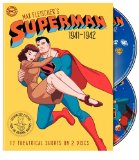| Reviews & Columns |
|
Reviews DVD TV on DVD Blu-ray 4K UHD International DVDs In Theaters Reviews by Studio Video Games Features Collector Series DVDs Easter Egg Database Interviews DVD Talk Radio Feature Articles Columns Anime Talk DVD Savant Horror DVDs The M.O.D. Squad Art House HD Talk Silent DVD
|
DVD Talk Forum |
|
|
| Resources |
|
DVD Price Search Customer Service #'s RCE Info Links |
|
Columns
|
|
|
Max Fleischer's Superman: 1941-1942
THE MOVIE:
NOTE: This review has been updated since press time to accommodate further research and information sent in by readers. Thanks to all who gave feedback.
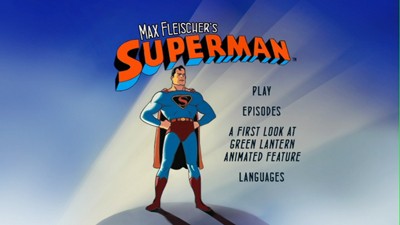
Man, I have been waiting for this DVD ever since I first bought a DVD player. Despite the existence of numerous public domain discs collecting the 1940s Superman cartoons, I never took a chance on any of them. I was burnt far too often in the 1980s buying low-rent VHS tapes with murky transfers that only had a handful of the shorts. I know I even bought a couple because I they had one or two I hadn't gotten before, ending up with a ridiculous amount of copies of "The Bulleteers" and "The Mechanical Monsters" and all of the other regular repeats, most of them from the pre-War production period. I didn't want to fall into the same trap. I wanted a credible, complete DVD from a company I could trust.
At long last, that DVD is here in the form of a 2-disc collection from Warner Bros.: Max Fleischer's Superman: 1941-1942. In the tradition of the studio's fantastic collections of the Fleischer Popeye cartoons, this set dips into the Paramount vaults to dig out the best possible elements to bring the Superman series into the digital age with class. Though not perfect, these new transfers are close enough to stifle most grumbling. Without a doubt, the animated Man of Steel is looking far better than he has in a long time.
Paramount created seventeen Superman cartoons over the course of two years. Max produced and Dave Flesicher directed the first half of the set, while the studio took over the rest of the productions. This transition from the comic book page to the screen marked the first time that the character appeared in a different visual media (he had been on the radio since the year prior, and actor Bud Collyer voiced him for both that program and these cartoons). It also marked a significant advancement for the Fleischer Studios, taking them into more conventional adventure territory. Though they had made the full-length adaptation of Gulliver's Travels at the end of the 1930s, that feature skewed closer to the humorous endeavors of their more famous shorts. The Superman series was straightforward, uncomplicated, and relied on a fast-paced story to deliver an exciting shot of action.
In addition to adapting their storytelling style to better fit this well-known character, the Fleischer animation crew also ratcheted up their visual technique. The Superman shorts are Technicolor marvels. The animation is fluid and malleable, creating a believable art-deco illusion of the modern world, but one that was bendable and expressive. So, a realistic looking train could speed around the corner of a mountainside rail that stretched to fit its movements, or a toppling building would lean toward the Earth like a big cone of rubber that Superman could push back to standing tall. One of the best effects was dropping out the black lines on some of the character designs, creating a lively and illustrative look. By contrast, many of the machines, be it an armored car or a deadly robot, were drawn with detailed precision. The combination established a slightly surreal environment that made full use of the fact that it was a cartoon to create maximum thrills.
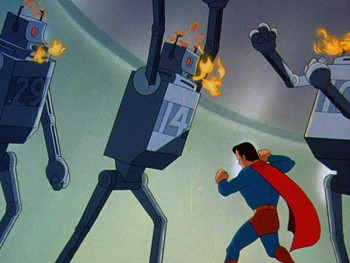
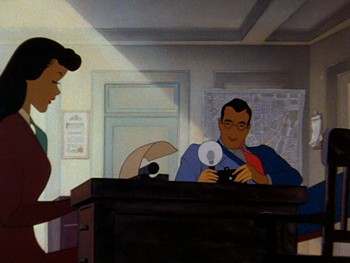
The series began with "Superman," which gave a short rundown of the big man's origin but then jumped straight into the adventure. A mad scientist is using a powerful laser cannon to terrorize Metropolis, and when Lois Lane (Joan Alexander) gets herself into trouble, Clark Kent changes to Superman and swoops in to save the day. The plot for this initial entry set up the formula that would run through the series: establish threat, separate Lois and Clark, send in Superman for the win, close on a joke between the reunited Lois and Clark. It's actually not that different than the story pattern the Fleischers used for Popeye. Substitute the salty sailor's can of spinach for Clark ripping off his suit in the shadows, and you have the same transformative moment that the audience waits for time and again, knowing that when it comes, evil will fail. In addition to this formula, some sources suggest "Superman" also established that now famous introduction: "Faster than a speeding bullet! More powerful than a locomotive!" etc. In this version of events, the radio show would soon pick up this famous tag, though one commentator, WB animation director Dan Riba, says in the bonus features that it's actually the radio show that informed the animation. Either way, the slogans would be used for most of the future incarnations of Krypton's most popular son right up to the first Christopher Reeve movie in 1978.
In the cartoons, Supes doesn't end up fighting any of his iconic nemeses. Instead, he tackles a variety of human menaces. They are mainly power-hungry scientists or anonymous thugs, most of whom have some kind of technological advancement that they are using to try to fleece Metropolis (or at least in the case of "Electric Earthquake," Manhattan). The thieves in "Billion Dollar Limited," for instance, drive an armored roadster in pursuit of a train with a valuable cargo; in "The Magnetic Telescope," it's a selfish astronomer whose experiments with a high-powered magnet threaten to bring fiery comets down on the city. Breaking from the norm in a few cartoons, such as "The Arctic Giant" and "The Mummy Strikes," Superman does battle with monsters and supernatural creatures--though I think the effect is usually not as strong. The penultimate entry in the series, "The Underground World," takes our cast to the depths of the Earth where they battle human/bird hybrids, and the fantasy gets stretched a little thin.
Fights with birdmen aside, for most of 1942, like a lot of Hollywood and his cartoon brethren, the Man of Steel was putting in his time with the war effort, taking on Japanese spies and Nazi saboteurs both abroad and at home. There is even a switch-up where Superman is the saboteur, when for some inexplicable reason Clark and Lois go to Tokyo on assignment in "The Eleventh Hour." Not unexpectedly, some of the portrayals on other races and nationalities veer into physical and vocal stereotypes, though the caricatures aren't nearly as grotesque as some of the propaganda-fueled animated comedy shorts of the period.
The shift into wartime stories takes place on DVD 2, which is also the division between the Max Fleischer-directed material and the shorts helmed by others. The change is slight, but perceptible. The style solidifies, becomes less fluid, particularly in terms of character modeling. Perhaps the best example of where things could have gone wrong is a stock comedic character that shows up in two of the shorts, a squeaky-voiced boy named Louis who works at the Daily Planet. He could have been imported from any generic cartoon, and his presence clashes with the specialness that had come to define the series.
Two things that remain constant, however, are the adventurous lighting techniques and the music. The former borrows heavily from mystery movies and crime thrillers, employing shadows and abstraction to create more suggestive images. The latter is provided by Sammy Timberg, and his sense of drama is impeccable. The music is anthemic, almost like a call to arms, and like so many other things in these cartoons, set the tone for the kind of music that would accompany Superman's further cinematic adventures.
It's funny watching these cartoons again, because Lois strikes me as a rather annoying character now. She never heeds warnings, always goes where she doesn't belong, and ends up complicating things. Selfish through and through, she also cuts Clark out of the byline action, even going so far as to hide his press pass so he can't get into restricted areas in "Volcano." And she's certainly not as smart or as inquisitive a reporter as she thinks, since she never manages to even question why Superman ends up wherever she goes, be it Tokyo, the African jungle, or deep underground. Superman must have gotten super patience with all of his other powers to keep putting up with her!
Or maybe he didn't, because Lois is absent for the last of the Fleischer cartoons. "Secret Agent" ends the series with a particularly good script featuring Superman helping a blonde spy outrun the Nazis and deliver the secrets she's discovered to Washington. Given the era, it's extremely fitting that the last shot we see of the Man of Steel shows him flying past an American flag, his hand raised in a salute. An American hero rocketing off on a high note.

THE DVD
Video:
"The Original and Best, Remastered from Superior, Original Vault Elements!" So screams the back cover of Max Fleischer's Superman, and who am I to doubt? These truly are good looking full-frame transfers. The colors are bright and vibrant, and though the prints do all show some surface scratching, spots, and pops, they are all very clear. Occasionally, there is a strange edit or an out-of-place fade that almost seems to be inserted to allow for a commercial break, but I don't know one way or the other if those have always been there or not. Even if they weren't, I wouldn't take it as meaning anything is missing, as these all appear to be complete and untouched (to the best of my knowledge).
For a comparison of some of the earlier public domain releases, please read John Sinnott's review comparing the Bosko and VCI editions here.
Reader Updates: Thanks to Andrew Rubio, who wrote in to inform me of the following: "Just FYI - Warner made changes during the remastering of these shorts. The prologues have been altered from their theatrical releases with mistaken openings put on the wrong shorts and an audio glitch that exists on most of them. The changes only effect the prologues."
I seem to recall there being other changed openings on cartoon collections in the past. Obviously, this won't hurt your enjoyment of the main content, but it's something you might want to be aware of anyway.
Also thanks to reader Brandon Cordy, who not only backed up Andrew by saying that the intros on the shorts are not entirely accurate to the original releases, but also noted that the fades I saw are part of the production and corrected some of the misconceptions about the Fleischers' involvement that have been floating around.
Update April 14: It should be noted that one of the opening pieces in contention is the intro to "The Mechanical Monsters," which features a short mention of X-Ray vision and an effect illustrating that power. This has been restored, suggesting that there has been further improvement since the transfers used on the Superman Ultimate Collector's Edition set. To see more of the ongoing discussion regarding this set, please visit the topic thread on our forum.
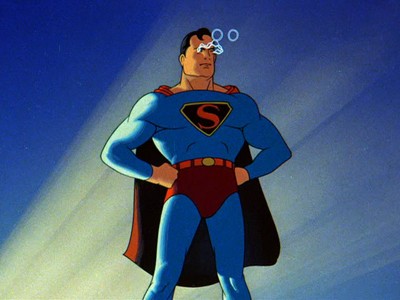
Sound:
A mono mix gives a good scrubbing to some old soundtracks, though a slight metallic, distorted quality does creep in here and there. Overall, the audio is solid and likely better for not adding any fancy, anachronistic modern effects. Given the constant presence of music in the cartoons, Max Fleischer's Superman: 1941-1942 gives the appropriate amount of attention to the score so that, whatever else may be off the mark, the tunes always sound terrific.
Subtitles are available in English Closed Captioning and French.
Extras:
DVD 1 has one extra, a sneak preview of the upcoming animated Green Lantern movie. This is a 10-minute promo reel featuring animators, comics people, and the voice actors giving an overview of the Green Lantern character and talking about the film. No actual animation is shown, but we do get a glimpse at storyboards and production drawings. Decent as far as content, but really more of a commercial than an extra relating to these cartoons.
DVD 2 has two documentaries to shed some light on Superman and the Superman cartoon series. "The Man, The Myth, Superman" (13 minutes, 35 seconds) traces the precedents for a character like Superman in ancient stories and myths and asks why these champions endure. "First Flight: The Fleischer Superman Series" (12:53) looks at the innovations the shorts made in terms of animation and the iconic nature of the title character, as well as the working technique of the Fleischers. Both gather contemporary animators and Fleischer associates, historians in various fields, and comic book experts and creators to hash over the history.
Both discs come in a standard-sized plastic keep case with a hinged interior tray so that each disc has its own space. In addition to the plastic case, there is a nice outer slipcover. Both covers feature the same art, though, so we are not treated to the excellent design work we have seen on some of the other Warner Bros. animation sets. In fact, I found the menu art to be kind of sub par.
FINAL THOUGHTS:
Highly Recommended. Could it be any other way? Max Fleischer's Superman: 1941-1942 is a fantastic set, giving us the best copies I've seen of the influential initial cinematic foray of the Man of Steel. These are extremely fun cartoons, full of vitality even after all these years. A marvelous animation style brings solid adventure stories to life in a kinetic manner, utilizing sophisticated film techniques to elevate the art of animation in ways that remain hard to match. Even in this era of comic book movies, Max Fleischer's Superman still ranks among the best.
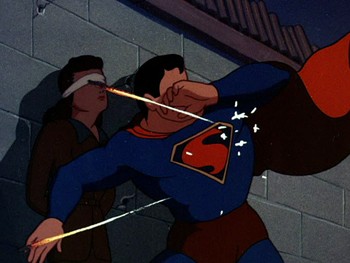
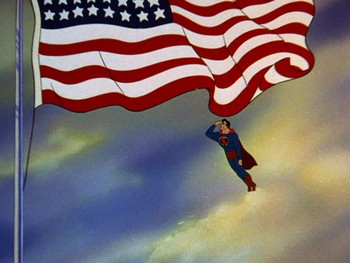
Jamie S. Rich is a novelist and comic book writer. He is best known for his collaborations with Joelle Jones, including the hardboiled crime comic book You Have Killed Me, the challenging romance 12 Reasons Why I Love Her, and the 2007 prose novel Have You Seen the Horizon Lately?, for which Jones did the cover. All three were published by Oni Press. His most recent projects include the futuristic romance A Boy and a Girl with Natalie Nourigat; Archer Coe and the Thousand Natural Shocks, a loopy crime tale drawn by Dan Christensen; and the horror miniseries Madame Frankenstein, a collaboration with Megan Levens. Follow Rich's blog at Confessions123.com.
|
| Popular Reviews |
| Sponsored Links |
|
|
| Sponsored Links |
|
|
| Release List | Reviews | Shop | Newsletter | Forum | DVD Giveaways | Blu-Ray | Advertise |
|
Copyright 2024 DVDTalk.com All Rights Reserved. Legal Info, Privacy Policy, Terms of Use,
Manage Preferences,
Your Privacy Choices | |||||||









